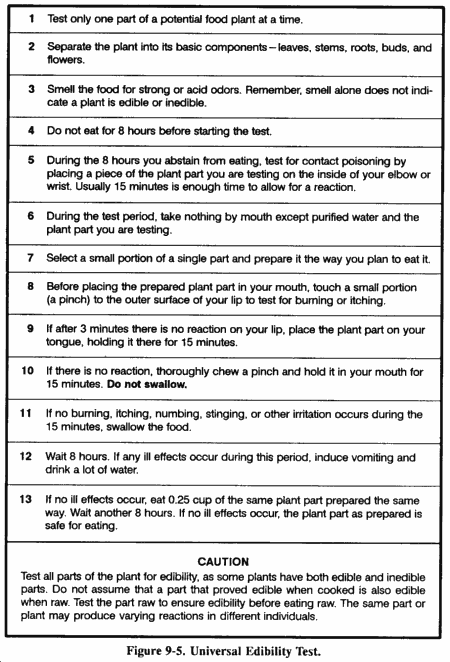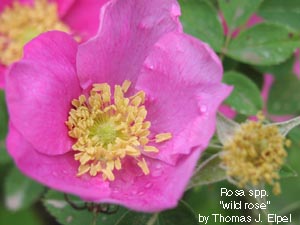 Edible Plants
Edible Plants
By: Marissa Wolfgram
Weather you are lost in wilderness and need to eat plants for survival, or want to try to mix things up with some colorful flowers on a dinner plate, plants are a great source of food and are always accessible. No matter the reason for eating plants do not take any risks, and be able to positively identify the plant before you eat it. A miscalculation of the plant can result in making you feel very sick or even cause death.
It is important to know that some plants have both edible and poisons parts, and some are only edible during certain times of the year. Before eating a wild plant Wilderness Survival web site says you should apply the Universal Edibility Test. This test can help you pick out if the plant is edible or not.
UNIVERSAL EDIBILITY TEST
http://www.wilderness-survival.net/plants-1.php

Even though the Universal Edibility Test can help you distinguish between edible and non edible plants you still need to be careful. Wilderness Survival gives some tips to help you avoid eating the poisons plants. When you are unable to identify a wild plant do not eat it if the plant has any of these characteristics:
- Milky or discolored sap.
- Beans, bulbs, or seeds inside pods.
- Bitter or soapy taste.
- Spines, fine hairs, or thorns.
- Dill, carrot, parsnip, or parsley like foliage.
- "Almond" scent in woody parts and leaves.
- Grain heads with pink, purplish, or black spurs.
- Three-leaved growth pattern.
Edible plants in the Mid-West
 |
 |
 |
 |
 |
Here are 20 edible plants Dr. Deborah Lee has listed that grow in the Mid-West region. The edible parts of each plant are listed for your information and some photos of the plants are above.
1. Acer Supp. (Maple Tree) edible parts: inner bark, seeds
2. Allium supp. (wild Onion)
edible parts: leek bulb and leaves
3. Arisaema atrorubens (Jack in the Pulpit) edible parts: Corm (well dried)
4.
Asclepias supp. (Milkweed) edible parts: sprouts, leaves, flowers buds, young fruits.
5. Barbarea spp. (Birch Tree) edible parts: sap, inner bark, twigs
6. Celtis sapp. (Hackberry tree) edible parts: fruits
7. Chrysanthemum leucanthemum (Ox-Eye Daisy) edible parts: young leaves
8. Commelina spp. (dayflower) edible parts: young leaves and stem
9. Fragaria spp. (Wild Strawberries) edible parts: fruit, and leaves
10.
Claytonia spp. (Spring Beauty) edible part: corm
11. Robinia pseudo-acacia (Black Locust) edible part: flowers (only)
12. Rosa spp. (Wild Rose) edible parts: petals, fruits
13. Pteretis pensylvanica Ostrich Fern fiddlehead
14. Pyrus angustifolius Crap Apple edible parts: fruits
15. Pyrus, spp. Chokeberry, Chokecherry fruits
16. Quercus spp. Oak edible parts: acorns
17. Rhexia virginica (Meadow Beauty) edible part: tender leaves and tubers
18. Ribes spp. (Gooseberries) edible parts: fruits
19. Nymphaea spp. (Water Lily) edible parts: young leaves, flowerbuds,seeds and tubers
20. Opuntia humifusa (Prickly-Pear) edible parts: young leaf pads, fruit and seeds
For a list of all the plants she has labled as edible vistit her website at: http://www.healthunlimitedplus.com/wild_edibles.pdf
 Treatment
Treatment
Dr. Ann King Filmer and her web site Know Your Plants... Safe or Poisonous, give directions and steps to take if you do happen to eat or touch a poisonus plant.
Mouth: Remove any remaining parts of the plant or mushroom from victim's mouth and clean out the mouth. Give a small amount of water.
Skin: Wash any skin exposed to the plant with soap and cool water as soon as possible.
Eyes: Flush eyes with lukewarm water for 10-15 minutes. Be very gentle, as vigorous or prolonged rinsing can hurt the eyes.
If vomiting is recommended by the Poison Control Center or your doctor, use only Syrup of Ipecac. Do not use anything else, and do not put your finger in the throat to cause gagging, which can cause more injury.
If advised to take the person to the hospital, bring the plant or a piece of it along with the label.
Contact Information:
E-Mail Address: Marissa.Wolfgram@ndsu.edu
Photos are from:
http://4.bp.blogspot.com/_eaKbvlcIK10/Sr2EN1s9ZPI/AAAAAAAAGAU/mTdK0kIhgDY/s400/commelina+coelestis+flower+(own).jpg
http://1.bp.blogspot.com/__OOpzs3KGa4/SHKyiQln1pI/AAAAAAAADqo/lmCOLb_ewL4/s400/P1080056.JPG
http://4.bp.blogspot.com/_kBKywbjYFjA/StItio7NtZI/AAAAAAAAAHE/3t3QaF43b2U/s400/fragaria_vesca_wild_strawberry.jpg
http://wp.macfusion.org/wp-content/uploads/2009/05/black-locust.jpg
http://farm4.static.flickr.com/3397/3234310355_0d2964d208.jpg
http://www.wilderness-survival.net/plants-1.php
http://www.diymedicalnetwork.com/uploads/1000/poison_sign.png?1202788551
Information was found on:
http://www.healthunlimitedplus.com/wild_edibles.pdf
http://www.wilderness-survival.net/plants-1.php
http://www.plantsciences.ucdavis.edu/ce/king/PoisPlant/